Birth name John Smith Thach Name John Thach Rank Admiral | Years of service 1927–1967 Nickname(s) Jimmy | |
 | ||
Born April 19, 1905Pine Bluff, Arkansas ( 1905-04-19 ) Allegiance United States of America Commands held VF-3, United States Naval Forces Europe | ||
Us navy lt edward o hare and lcdr john thach of vf 3 prepare for flight at kane hd stock footage
John Smith "Jimmy" Thach (April 19, 1905 – April 15, 1981) was a World War II naval aviator, air combat tactician, and United States Navy admiral. Thach developed the Thach Weave, a combat flight formation that could counter enemy fighters of superior performance, and later the big blue blanket, an aerial defense against Kamikaze attacks.
Contents
- Us navy lt edward o hare and lcdr john thach of vf 3 prepare for flight at kane hd stock footage
- Dimitrij ovtcharov vs john thach tran open singles rr group 1
- Early career
- World War II
- Post World War II
- Personal life
- References
Dimitrij ovtcharov vs john thach tran open singles rr group 1
Early career
John S. Thach was born in Pine Bluff, Arkansas. He graduated from the United States Naval Academy in 1927 and spent two years serving in battleships before training as a naval aviator in 1929. Thach spent the next decade serving as a test pilot and instructor and establishing a reputation as an expert in aerial gunnery.
World War II
In the early 1940s, he was placed in command of Fighting Squadron Three (VF-3). There he met a young Ensign just out of flight school, Edward O'Hare, later a Medal of Honor recipient. Thach made O'Hare his wingman and taught him everything he knew. At the U.S. Navy fleet gunnery competition at the end of 1940, eight of the 16 VF-3 pilots qualified for the gunnery "E" award ("excellence").
Later Thach developed a fighter combat tactic known as the Thach Weave. This tactic enabled American fighter aircraft to hold their own against the more maneuverable Mitsubishi A6M Zero, the primary Imperial Japanese Navy fighter.
Lieutenant Commander Thach and VF-3 flew from USS Lexington in the early part of World War II, and was assigned to USS Yorktown during the Battle of Midway in June 1942.
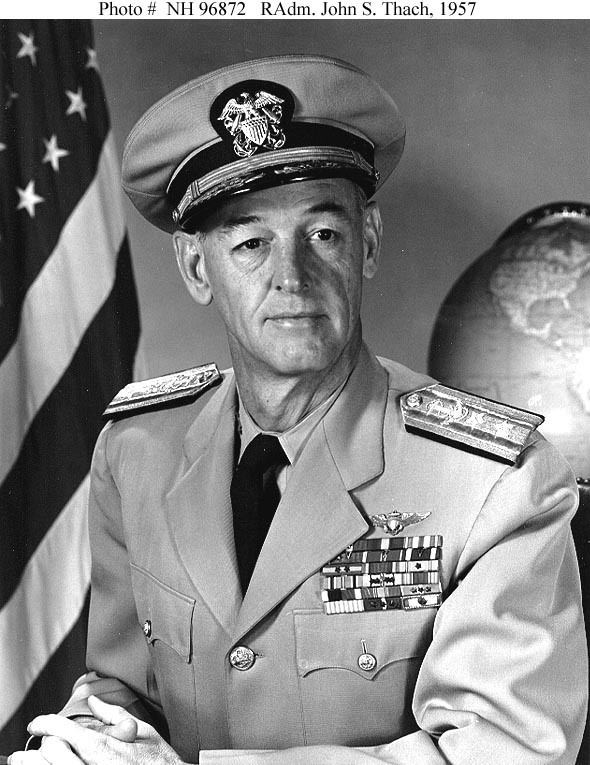
On the morning of June 4, 1942, Thach led a six-plane sortie from VF-3, escorting twelve Douglas TBD Devastators of VT-3 led by Lieutenant Commander Lance Massey from Yorktown, when they discovered the main Japanese carrier fleet. They were immediately attacked by 15 to 20 Japanese fighters. Thach decided to use his namesake maneuver, marking its first combat usage. Although outnumbered and outmaneuvered, Thach managed to shoot down three Zeros and a wingman accounted for another, at the cost of one Grumman F4F Wildcat.
After Midway, Thach was assigned to instruct other pilots in combat tactics. The U.S. Navy pulled its best combat pilots out of action to train newer pilots, while the Japanese kept their best pilots in combat. As the war progressed, the Japanese Navy lost their experienced pilots due to attrition and had no well trained replacements, while the U.S. was able to improve the general fighting ability of their own personnel. When the Japanese resorted to the feared Kamikaze suicide attacks, Thach developed the "big blue blanket" system to provide an adequate defense.
Later in the war Commander Thach became Operations Officer to Vice Admiral John S. McCain, Sr., commander of the Fast Carrier Task Force. Thach was also present at the formal Japanese Surrender aboard USS Missouri on September 2, 1945 in Tokyo Bay.
Thach was a flying ace, credited with shooting down six enemy aircraft during World War II.
Post World-War II
Thach commanded Sicily (CVE-118) during the Korean War and Franklin D. Roosevelt (CVA-42) in 1953–54. He was promoted to Rear Admiral in 1955.
In 1958 and 1959 Thach was placed in command of an antisubmarine development unit, "Task Group Alpha", with the aircraft carrier Valley Forge (CVS-45) serving as his flagship. He subsequently appeared on the cover of Time magazine on September 1, 1958 for his contributions to anti-submarine warfare (ASW), which was a primary focus at the time in the ongoing Cold War. An annual award was later established in his name for presentation to the top ASW squadron in the Navy.
He was promoted to Vice Admiral in 1960 and served as the Deputy Chief of Naval Operations for Air in the Pentagon where he presided over development of the A-7 Corsair II among other Naval Aviation programs. As Commander in Chief, U.S. Naval Forces, Europe, starting in 1965 he pinned on his fourth star as a full admiral, retiring from the Navy in May 1967 from that position.
The Arkansas Aviation Historical Society inducted Thach into the Arkansas Aviation Hall of Fame in 1981.
John Thach died on April 15, 1981, in Coronado, California, four days before his 76th birthday, and was buried at Fort Rosecrans National Cemetery in San Diego. The frigate Thach (FFG-43) was named in his honor.
Personal life
John Thach and his wife Madalynn had four children.
